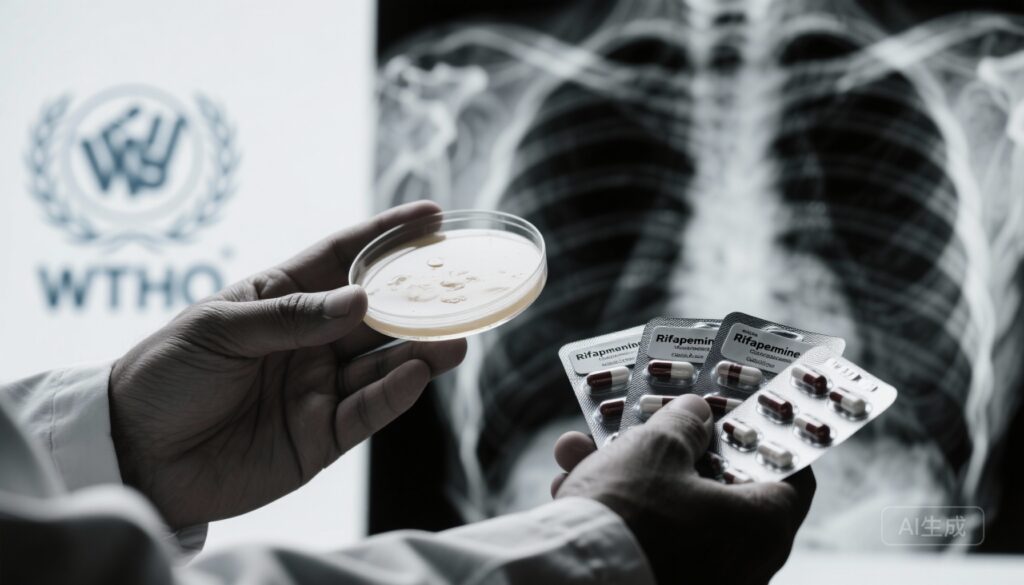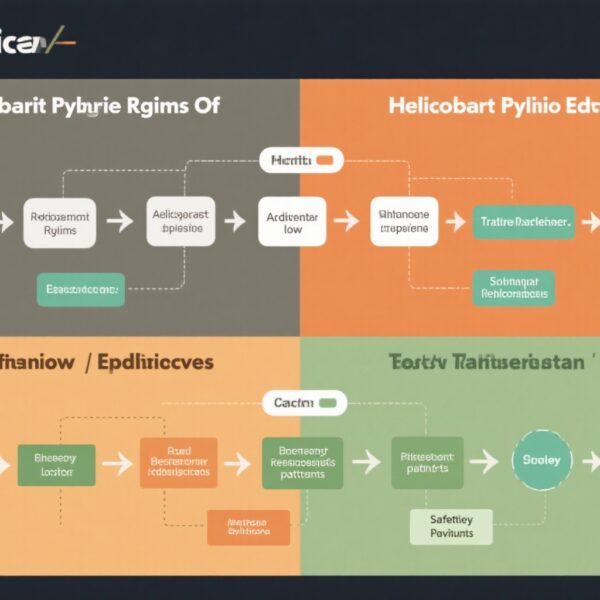Highlights
– The Clo‑Fast randomized phase 2c trial compared a 3‑month rifapentine–clofazimine containing regimen (with a 2‑week clofazimine loading dose) to the standard 6‑month isoniazid‑rifampicin regimen for drug‑susceptible pulmonary tuberculosis.
– By week 12, sputum culture conversion rates were similar (≈89% in the experimental arm vs 90% control), but the trial was stopped early because the 3‑month regimen produced significantly more grade 3+ adverse events and a higher probability of unfavourable outcomes by week 65 (52% vs 27%).
– The study indicates that adding clofazimine to a rifapentine‑based short course does not reliably permit safe treatment shortening in this formulation and dosing, and underscores the need for careful safety and PK evaluation with novel TB regimens.
Background and Unmet Need
Tuberculosis (TB) remains a leading infectious cause of morbidity and mortality worldwide. Long treatment duration for drug‑susceptible pulmonary TB (standard 6 months) contributes to default, programmatic challenges, and resource use. There is high clinical and public‑health interest in safe, effective shorter regimens that maintain durable cure and minimize toxicity.
Rifapentine, a long‑acting rifamycin, and clofazimine, a lipophilic riminophenazine with intracellular activity, have both attracted attention in regimen design. Rifapentine‑containing regimens achieved successful 4‑month treatment shortening in some studies when combined with fluoroquinolones (NEJM 2021), while clofazimine has been repurposed in multidrug‑resistant TB (MDR‑TB) regimens for its sterilizing activity. Preclinical and early clinical data suggested potential synergy for treatment shortening when clofazimine is combined with rifapentine and conventional first‑line drugs, prompting the Clo‑Fast trial to evaluate a 3‑month five‑drug regimen for drug‑susceptible TB.
Study Design
Clo‑Fast was an investigator‑initiated, randomized, open‑label, phase 2c trial conducted at six sites across five countries (ClinicalTrials.gov NCT04311502). Adults (≥18 years) with pulmonary TB who were sputum smear‑positive or molecular assay positive for Mycobacterium tuberculosis susceptible to rifampicin and isoniazid were eligible; people living with HIV were allowed if CD4 count ≥100 cells/mm3.
Randomization was 2:1 (group 1: group 2) or 2:1:1 (group 1: group 2: group 3) when participants consented to intensive PK sampling for group 3. Key regimens:
– Group 1 (experimental, 13 weeks): 8 weeks of rifapentine + isoniazid + pyrazinamide + ethambutol + clofazimine (with a 2‑week 300 mg clofazimine loading dose), followed by 5 weeks of rifapentine + isoniazid + pyrazinamide + clofazimine.
– Group 2 (control, standard of care): 8 weeks of isoniazid + rifampicin + pyrazinamide + ethambutol, followed by 18 weeks of rifampicin + isoniazid (6 months total).
– Group 3 (PK substudy): identical to group 1 for the first 4 weeks but without the clofazimine loading dose (100 mg daily); thereafter participants returned to local standard of care to complete therapy.
Randomization was stratified by HIV status and extent of radiographic disease. The primary efficacy endpoint was time to stable sputum culture conversion by 12 weeks. The primary safety endpoint was proportion of participants experiencing any grade 3 or worse adverse event through 65 weeks. A key secondary endpoint was a composite ‘unfavourable’ clinical or bacteriological outcome by week 65.
Key Results
Participants and trial conduct
104 participants were randomized: group 1 n=58, group 2 n=31, group 3 n=15. The cohort was predominately male (79%) and had a high prevalence of radiographically advanced disease (71%); 29% were people with HIV. The trial was stopped early for lack of clinical efficacy and safety concerns.
Primary efficacy: sputum culture conversion by 12 weeks
Among the primary efficacy population (excluding late exclusions and those with baseline resistance), stable culture conversion by week 12 occurred in 49 of 55 participants (89%) in group 1 versus 28 of 31 (90%) in group 2. The adjusted hazard ratio was 1.21 (90% CI 0.82–1.79; p=0.2089), indicating no statistically significant improvement for the 3‑month regimen.
Safety outcomes
Grade 3 or worse adverse events occurred in 26 of 58 participants (45%) in the experimental group compared with 5 of 31 (16%) in the control group (absolute difference 30%; 90% CI 14–45; p=0.002). The trial manuscript reports an excess of serious toxicity in the experimental arm that contributed materially to treatment discontinuations and protocol deviations.
Composite clinical outcomes at 65 weeks
The cumulative probability of an unfavourable outcome by week 65 was substantially higher in the experimental arm: 52% (95% CI 37–69) versus 27% (95% CI 14–50) in the control arm (p=0.049).
Interpretation of results
Although early bacteriologic conversion at 12 weeks was similar between arms, the experimental 3‑month regimen produced a markedly worse safety profile and a higher rate of unfavourable clinical outcomes by 65 weeks, prompting early trial termination. The dissociation between 12‑week culture conversion and long‑term clinical outcomes highlights the need to evaluate both early bacteriologic markers and durable clinical endpoints when assessing regimen shortening.
Expert Commentary and Mechanistic Considerations
Why might a regimen that achieves early culture conversion still produce worse longer‑term outcomes and excess toxicity?
– Safety‑driven interruptions: Greater frequency of grade 3+ adverse events in the experimental arm likely led to treatment interruptions, dose reductions, or early discontinuation, undermining regimen efficacy despite similar early bacteriologic responses.
– Cumulative toxicity of multi‑drug intensification: The experimental arm combined a potent rifamycin (rifapentine) with clofazimine and standard first‑line agents. Clofazimine is lipophilic and accumulates in tissues; adding a loading dose may have increased early exposures and toxicity. While clofazimine is generally well tolerated in MDR‑TB regimens, its safety profile in combination with high rifapentine exposure and standard drugs in drug‑susceptible TB requires specific evaluation.
– Pharmacokinetic and pharmacodynamic interactions: Rifamycins induce drug‑metabolizing enzymes and transporters, which can alter companion drug exposures. Conversely, coadministration of clofazimine and rifapentine may have altered effective drug levels in ways that are not fully predictable from preclinical models.
– Patient population and disease severity: The trial enrolled a high proportion with radiographically advanced disease, which can be harder to cure with shortened regimens; small sample size and early stopping limit the ability to explore subgroup effects such as HIV status.
These possibilities emphasize the importance of integrating detailed PK/PD, safety, and adherence data into regimen development, and the value of randomized comparisons to detect unexpected harms.
Strengths and Limitations of Clo‑Fast
Strengths:
– Randomized design and stratification by HIV status and disease extent.
– Prespecified clinical and safety endpoints with prolonged follow‑up to 65 weeks.
– Inclusion of a PK substudy arm to probe the impact of a clofazimine loading dose.
Limitations:
– Early termination reduced sample size and statistical power for some comparisons and subgroup analyses.
– Open‑label design may have influenced reporting and management of adverse events.
– The trial population had a high prevalence of advanced disease and male predominance, which may affect generalizability.
– The published report does not present granular, aggregated data on types of grade ≥3 adverse events in the summary; full safety tables and PK data will be important to interpret mechanisms.
Clinical Implications and How This Fits with Other Evidence
Clo‑Fast provides a cautionary example that promising preclinical or early clinical activity does not guarantee that a shortened regimen will be safe and clinically effective. The findings contrast with trials demonstrating successful shortening using rifapentine combined with moxifloxacin to 4 months (Dorman et al., NEJM 2021), underscoring that regimen components, drug‑drug interactions, dosing, and patient selection critically determine outcomes.
For clinicians and programs, the trial indicates that the particular 3‑month rifapentine–clofazimine regimen tested should not be adopted for drug‑susceptible TB. Standard 6‑month therapy remains the appropriate standard of care for these patients unless alternate shortened regimens are supported by robust evidence of comparable safety and durable efficacy.
For researchers and drug developers, Clo‑Fast highlights the following lessons:
– Safety must be a coequal endpoint with early bacteriologic efficacy in trials of regimen shortening.
– PK/PD characterization, including evaluation of loading doses and tissue accumulation, is essential before wide testing of combinations with agents like clofazimine.
– Sequential, stepwise clinical evaluation with early stopping rules is appropriate to protect participants when unanticipated harm emerges.
Conclusions
The Clo‑Fast phase 2c trial tested a 3‑month rifapentine‑ and clofazimine‑containing regimen against standard 6‑month therapy for drug‑susceptible pulmonary TB. While early culture conversion at 12 weeks did not differ significantly between arms, the experimental regimen produced substantially more grade 3 or worse adverse events and a higher rate of unfavourable composite outcomes by week 65, leading to early termination. These results argue strongly against adopting this 3‑month regimen and underscore the need for thorough safety and PK evaluation when designing shortened TB regimens. Future research should focus on regimen combinations with demonstrated safety, carefully defined PK targets, and validation of surrogate markers that reliably predict durable cure.
Funding and Trial Registration
The trial was funded by the US National Institutes of Health Advancing Clinical Therapeutics Globally for HIV/AIDS and Other Infections (ACTG) and the National Institute of Allergy and Infectious Diseases. ClinicalTrials.gov identifier: NCT04311502.
Selected References
– Metcalfe JZ, Weir IR, Scarsi KK, et al.; ACTG A5362 study team. A 3‑month clofazimine‑rifapentine‑containing regimen for drug‑susceptible tuberculosis versus standard of care (Clo‑Fast): a randomised, open‑label, phase 2c clinical trial. Lancet Infect Dis. 2025 Sep 4:S1473‑3099(25)00436‑0. doi:10.1016/S1473‑3099(25)00436‑0.
– Dorman SE, Nahid P, Kurbatova EV, et al. Four‑Month Rifapentine–Moxifloxacin Regimen for Tuberculosis. N Engl J Med. 2021;384(18):1705‑1718. doi:10.1056/NEJMoa2033400.
– World Health Organization. WHO consolidated guidelines on tuberculosis. Module 4: Treatment — drug‑susceptible tuberculosis treatment. 2022 update. Available at: https://www.who.int/publications/i/item/9789240045064 (accessed Nov 2025).
– WHO consolidated guidelines on drug‑resistant tuberculosis treatment. World Health Organization; 2020–2022 updates.
(Readers are referred to the Clo‑Fast primary manuscript for full safety tables, PK analyses, and supplementary materials describing trial conduct and stopping rationale.)



